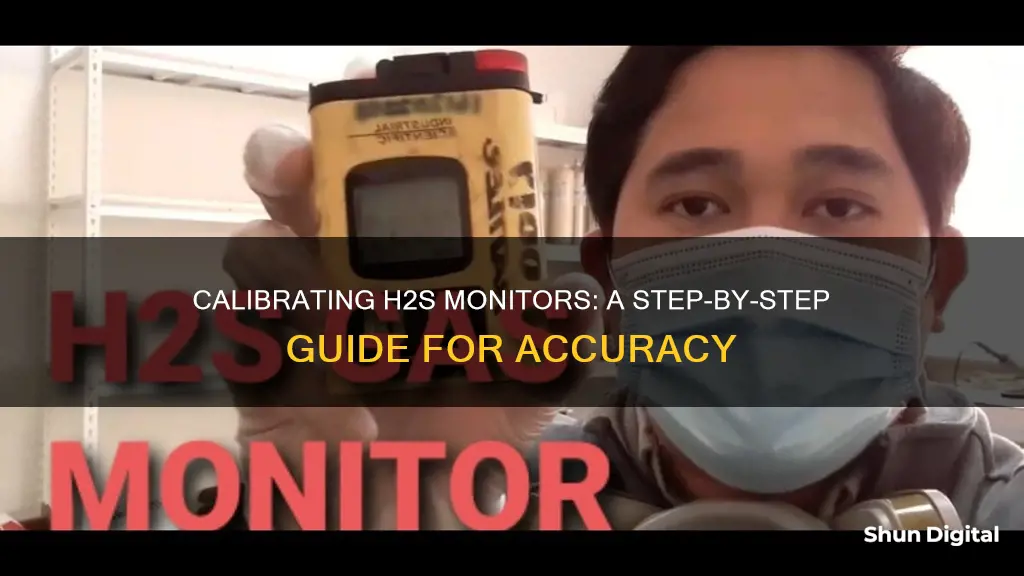
Calibrating H2S monitors is essential for maintaining safety in environments where hydrogen sulfide gas may be present. H2S is a toxic gas that can cause serious health issues and even death at high concentrations. To ensure accurate detection of H2S levels, it is crucial to calibrate H2S monitors periodically. This process involves adjusting the detector to a more precise reading, compensating for sensor drift and degradation over time. Calibration procedures can vary slightly depending on the type of H2S sensor, but the fundamental goal is to ensure the safety of individuals working or residing in areas where H2S exposure is a concern.
| Characteristics | Values |
|---|---|
| Purpose | To ensure accurate and reliable readings of H2S levels in the environment |
| Frequency | Every 6-12 months |
| Equipment | Calibration gas cylinder, regulator, calibration adapter, tubing, manufacturer's instructions |
| Safety Precautions | Well-ventilated area, personal protective equipment (PPE), safe mode away from hazardous gas sources |
| Zero Calibration | Warm up gas detector, attach regulator to calibration gas cylinder, connect tubing to regulator's outlet, use calibration adapter to connect tubing to gas detector's calibration port, place detector in fresh air, initiate zero calibration |
| Span Calibration | Replace fresh air cylinder with calibration gas cylinder, initiate span calibration, allow detector to sample calibration gas for specified duration, adjust reading to match known concentration of H2S |
| Verification and Adjustment | Perform bump test or verification test, consult manufacturer's guidelines for troubleshooting if readings are not acceptable |
| Documentation | Record calibration date, time, calibration gas concentration, deviations from expected readings, keep a log of all calibration activities |
What You'll Learn

Safety precautions
Before calibrating an H2S monitor, it is imperative to follow certain safety precautions to ensure the process is carried out effectively and securely. Here are the steps to take:
Ventilate the Area and Wear PPE:
Ensure you are in a well-ventilated area to avoid exposure to harmful gases. Put on appropriate personal protective equipment (PPE) to safeguard yourself from potential hazards.
Safe Mode and Distance:
Before initiating calibration, make sure the gas detector is in a safe mode, away from any hazardous gas sources. Keep a safe distance from potential gas leaks or sources to prevent accidental exposure.
Check Manufacturer's Instructions:
Refer to the manufacturer's instructions for specific recommendations regarding the calibration process. This includes information on the calibration gas cylinder, regulator, and any other necessary tools or equipment.
Prepare Calibration Equipment:
Gather and prepare the required calibration equipment and materials, such as the calibration gas cylinder, regulator, calibration adapter, tubing, and any other specified tools. Ensure you have the correct equipment for your detector model.
Zero Calibration:
Turn on the gas detector and allow it to warm up as per the manufacturer's guidelines. Attach the regulator to the calibration gas cylinder and connect the tubing. Use the calibration adapter to link the tubing to the gas detector's calibration port. Place the detector in fresh air, away from gas sources, and initiate the zero calibration process to set a baseline reading.
Span Calibration:
Replace the fresh air cylinder with the calibration gas cylinder containing the appropriate concentration of H2S gas. Start the span calibration process and allow the detector to sample the gas for the specified duration. Adjust the detector's reading to match the known concentration of H2S in the calibration gas.
Verification and Adjustment:
After calibration, perform a bump test or verification test to ensure the detector is functioning correctly. If the readings deviate from the expected values, refer to the manufacturer's guidelines for troubleshooting and making any necessary adjustments.
Documentation:
Record important details such as the calibration date, time, calibration gas concentration, and any deviations from expected readings. Maintain a log of all calibration activities, including dates, results, and corrective actions taken. This documentation ensures a record of calibration procedures and helps track the detector's performance over time.
By adhering to these safety precautions and following the manufacturer's instructions, you can effectively calibrate H2S monitors while prioritizing the safety of personnel and equipment.
Monitoring Hotspot Usage: A Comprehensive Guide to Tracking Data
You may want to see also

Equipment and materials
The equipment and materials required to calibrate an H2S monitor include:
- A calibration gas cylinder containing a known concentration of H2S gas. The specific concentration may vary depending on the manufacturer's instructions and the type of monitor being calibrated.
- A regulator to control the flow of calibration gas from the cylinder.
- A calibration adapter to connect the tubing to the gas detector.
- Tubing to connect the regulator to the calibration adapter.
- A gas detector or gas sensor to be calibrated. This could be a fixed or portable H2S gas detector, depending on the application.
- Personal protective equipment (PPE) to ensure the safety of the person performing the calibration.
- Tools and accessories as specified in the manufacturer's instructions for the particular model of the gas detector.
It is important to ensure that the calibration gas is not expired and that the correct concentration is used for the specific detector being calibrated. The calibration process may vary slightly depending on the exact type of H2S sensor, so it is essential to refer to the manufacturer's instructions and guidelines for the specific model. Additionally, the calibration equipment and materials should be set up in a well-ventilated area to ensure safety during the calibration process.
Studio Monitor Quirk: Sideways Setup, Why?
You may want to see also

Zero calibration
Step 1: Safety Precautions
Before beginning the calibration process, ensure you are in a well-ventilated area and are wearing appropriate personal protective equipment (PPE). Make sure the gas detector is in a safe mode, away from potentially hazardous gas sources.
Step 2: Gather Equipment and Materials
Check the manufacturer’s instructions for the recommended calibration gas cylinder and regulator for your specific detector model. Prepare the calibration gas cylinder, regulator, calibration adapter, tubing, and any other necessary tools.
Step 3: Initiate Zero Calibration
Turn on the gas detector and allow it to warm up according to the manufacturer’s instructions. Attach the regulator to the calibration gas cylinder and connect the tubing to the regulator’s outlet. Use the calibration adapter to connect the other end of the tubing to the gas detector’s calibration port.
Place the gas detector in an area with fresh air, away from any gas sources. Initiate the zero calibration process according to the manufacturer’s instructions. This process sets the baseline reading of the detector in clean air.
Step 4: Set the Zero Mark
After initiating the zero calibration, the detector will use the fresh air as a reference point to set an accurate zero mark. This zero mark represents an environment free of H2S gas.
Step 5: Verification
To verify the accuracy of the zero calibration, you can use a "zero air" mixture, which typically consists of 21% oxygen and 79% nitrogen. Pumping this mixture through the sensor will allow you to check if the sensor accurately recognises an H2S-free environment.
Step 6: Documentation
Record the date, time, and any relevant details of the zero calibration process. Keeping a log of calibration activities is important for maintenance and safety purposes.
Monitor Size: GPU Performance Impact?
You may want to see also

Span calibration
During span calibration, the detector is allowed to sample the calibration gas for a specified duration. The detector will then adjust its reading to match the known concentration of H2S in the calibration gas. This may involve manual adjustments using calibration screws, depending on the detector model. It is recommended to have two people perform this procedure, with one person at the sensor transmitter and the other at the sensor receiver to monitor the levels.
After completing the span calibration, it is important to perform a verification test, such as a bump test, to ensure the detector's response aligns with the expected values. If the readings are not within an acceptable range, refer to the manufacturer's guidelines for troubleshooting and adjustments. Properly calibrating an H2S gas detector ensures accurate and reliable readings of H2S levels, helping to maintain the sensitivity and accuracy of the instrument.
Eliminating Ghosting Issues on Your Monitor: A Practical Guide
You may want to see also

Verification and adjustment
After completing the span calibration, perform a quick bump test or verification test using a bump test gas to ensure the detector’s response aligns with the expected values. Bump testing is a procedure where the detector is exposed to a small amount of "blast" target gas to ensure it operates and alarms as programmed. The function of this test is to verify proper operation and build user confidence, particularly in hazardous applications.
If the readings are not within an acceptable range, consult the manufacturer’s guidelines for troubleshooting and adjustments. It is important to calibrate H2S monitors periodically to ensure accurate and reliable readings of H2S levels in the environment. Calibration helps maintain the sensitivity and accuracy of the instrument, thereby ensuring its effectiveness in detecting dangerous gas concentrations.
Calibration is especially important if the device is used as an analytical tool where accuracy is paramount, if the device is used in an extreme environment, or if the user is performing an imminently dangerous or extreme application. Bump testing should be performed daily in such cases, and if the bump test fails, calibration is required to ensure the sensors and monitor can alarm.
It is also important to have a calibration schedule that is strictly adhered to. Calibration and bump testing are mandatory as imminent injury or death will occur if the device fails. Take it very seriously.
Monitoring Data Usage on Your iPhone: A Quick Guide
You may want to see also
Frequently asked questions
An H2S monitor, also known as a hydrogen sulfide meter, hydrogen sulfide detector, or H2S gas detector, is a device that detects the presence of hydrogen sulfide gas in the air and measures its concentration, displaying levels in parts per million (ppm).
Calibration ensures that H2S monitors provide accurate and reliable readings of H2S levels in the environment. It helps maintain the sensitivity and accuracy of the instrument, thereby ensuring its effectiveness in detecting dangerous gas concentrations and protecting workers' health and safety.
It is recommended to calibrate H2S gas monitors every 6 to 12 months, as sensors may drift and degrade over time. Additionally, bump testing, which involves exposing the detector to a small amount of target gas to ensure proper operation, should be performed daily, especially in hazardous environments.







